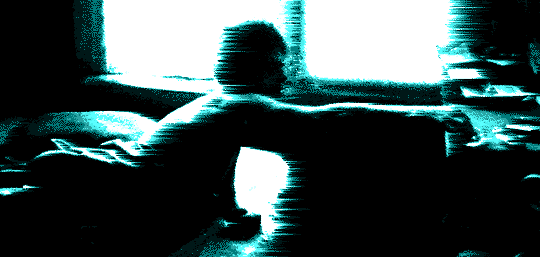

At Home with the Eels
88 N. Washington
Early in 1974 I met Brian and John in Columbus Ohio. They lived in a shabby house down the street and had no more reason to be in Columbus than I. Anything else we may have had in common at the time was not discernible because the Electric Eels were pathologically disagreeable. The Eels created their own reality.
They blurred all lines and built formidable barriers, turning fact into fiction and fiction into fact. They barely got along with each other and each was at war himself. Their energy was tremendous, challenging and addictive.
Their house, like its occupants, was strange and disorienting. The floor plan was odd with weird long hallways and rooms whose functions remain a mystery. Built before electricity, the ground floor had no ceiling fixtures, relying on ambient light for illumination. All reference to time of day obliterated by windows facing brick walls or so dirty and shaded that sunlight was indistinguishable from streetlight. There was no furniture, only John's art, an upright piano harp and an ocean of empties. It was not possible to walk across the floor. You had to shuffle through a shin-high scavenger's wet dream of recyclable bottles and cans. In the dim light the clinking of Rolling Rocks and Pabst Blue Ribbons served to announce a presence, but you could never be sure of who or what it might be.
The first time I saw Brian he came floating down the stairs with the biggest afro I'd ever seen on a white boy. Seeing company, he beat a retreat. Rerouting himself back up stairs as though doing this U-turn was the only thing he had come down to do. John called out in his big daddy way "when you gonna get a haircut, son?" John liked hackneyed "common man" humor. Brian responded with a wild eyed, "You mean a lobotomy?" his hands disappearing into the electrified mass to protect the sides of his skull.
Neighborhood cats would periodically take up residence in the dirt floor basement. This upset would drive the rat population upward and all night long you could hear them pounding their way through the walls. The basement was a water heater graveyard.
There were dozens, and a perpetual mist hanging at 3 feet. A counterpoint to the action in the basement was in the attic where the Eels' current, eight-nippled, drummer slept. Danny had a penchant for nymphets and nudist magazines, the kind that featured people frolicking innocently in the out of doors with their genitals airbrushed out. He was essentially a phantom who eventually vaporized.
The Eels were pure and predictable only in their passion for self destruction. It guided their personal lives and their musical careers. It explains why John would enroll in an art school in farm country. And why the Eels first song in a gay bar had to be "You Crummy Fags."
John was protective of his art. This posed a threat to all because it was not easy to identify his art. He had a rubber stamp reading "This Is Art" J. Regular. Disparate items were stamped in turquoise ink. Two other pieces I liked were the porch screen and the artist's suicide kit. The porch screen consisted of rural fencing strung between the railing and porch roof, knotted with multicolor strips of rags and plastic. They flopped around in the breeze shooing people away. The artist's suicide kit was a bicycle handle bar complete with plastic streamer hand grips connected at the stem to an electric cord with plug.
John, the contrary anarchist, wrote rules for artists. Things like"artists shave with two razors." He got really pissed off when I didn't identify the scrap of velvet scattered with broken red reflector plastic as art before I stepped on it. This huge hulking violent guy could also be a real big baby. Whining about how poor he was, John would dine on fresh artichokes and macadamia nuts as he waited for another check to arrive from his parents.
Brian worked at jobs usually reserved for ex- cons. He installed trailer hitches with an Elvis impersonator, where the embroidered name patches on all six of his uniforms read Brain. He also worked as a bell hop in an old-time athletic club.
He befriended a gay co-worker, who with each new day, grew closer to collapsing in a nervous breakdown. Those two would go out and get shitfaced. Brian was immune to emotional instability and oblivious to the influence he had on the poor man's accelerating decline. Brian would get bored in about 3 weeks and take another indiscriminately selected job. Together John, Michele and Brian once got a job building silos, traveling from farm to farm. They were a spectacle. Never altering their appearance or behavior to suit the job and unconcerned about the consequences.
One day Dave blew back into town. All I knew about Dave was that he traveled with a case of rat traps and a plastic blowup doll named Charlotte (after Peter Laughner's wife) which he stored in Brian's closet. Dave wore a plastic skin diver toy for a bracelet and a chronic sneer for a smile.
The Eels were impossibly impractical. Brian didn't mow but sickled the front lawn. He kept his beer in the garbage can out back; warm beer being preferable to sharing. Dave's rat traps were both costume and a communication device. Dave would set a line of them between Brian's bed and the toilet, his commentary on Brian's late night partying and tough shit to anyone else in need of relief.
Whether or not they had equipment was irrelevant to their perception of themselves as a band. Their priorities were, beer, a rehearsal space, and regular rehearsals. Not letting a lack of skills, tools or sobriety stand in their way, they devoted themselves to building hideously heavy Marshall bottoms. Brian covered his amp in pink fiberglass insulation, making it not only hard but painful and unhealthy to move.
They lived in crummy apartments and rode the bus but they always made sure they had a great space for the band. They were never into sex, drugs and rock n roll. They were Eels. And their life the performance.
Mary Burzynski 1996
 |
 |
 |
 |
 |
 |
 |
|